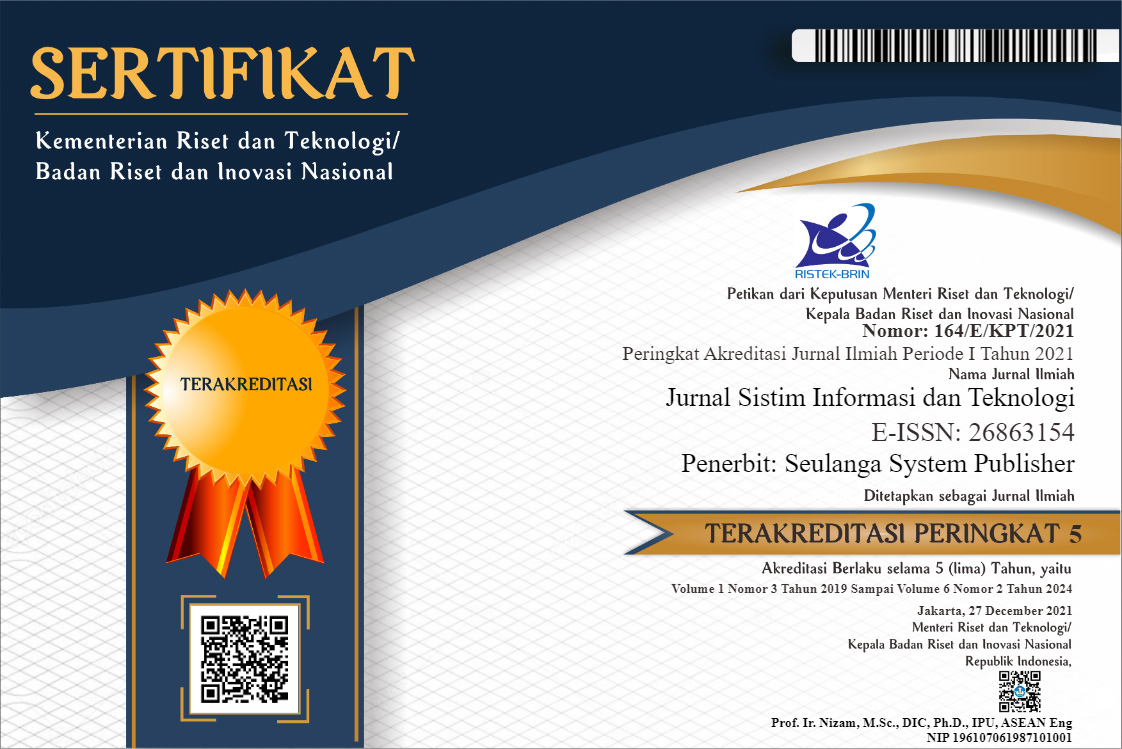Klasifikasi Tweet di Twitter dengan Menggunakan Metode K-Nearest Neighbor
DOI:
https://doi.org/10.37034/jsisfotek.v4i2.125Keywords:
Sentiment analysis, Classification, Twitter, Data Mining, K-Nearest NeighbourAbstract
Twitter is a social media and also a microblog that allows users to send and read short messages of no more than 280 characters as tweets. Tweet users are currently not limited in terms of age, information, and communication. The lack of information on tweets on Twitter results in a lot of information that is difficult to know the facts or intentions of the tweet. This can have negative impacts such as fraud, leading public opinion to negative. One of the topics that has been discussed in Indonesian society since March 2020. Coranavirus Disease 2019 (COVID-19) is a disease of the new type of coronavirus virus (SARS-CoV-2) that has taken the world by storm and the WHO has declared it a pandemic. As of March 10, 2022, 5.85 million Covid cases have been confirmed out of a total of 453 million cases in the world. This Covid-19 case can be a place for certain parties to disseminate information to the wider community. Tweet data obtained from social networks based on queries in Indonesian, this study aims to determine the pros or cons of the public or society against Covid-19. To find out that a tweet is counter can be done by looking at the existing tweets one by one, but this takes a long time and effort because of the large number of tweets. In this study using the K-Nearest Neighbor (KNN) method using as many as 1200 tweet data. Based on the research that has been done, it can be said that public sentiment in 2020 regarding COVID-19 tends to be negative, followed by positive and neutral opinions. But in 2021, as time goes by, public opinion tends to follow neutral.
References
Chiang, O. (2011, January 19). Twitter hits nearly 200M accounts, 110M tweets day, focuses on global expansion. Forbes.http://www.forbes.com/sites/oliverchiang/2011/01/19/twitter-hits-nearly-200m-users-110m-tweets-perday-focuses-on-global-expansion. Psychological Science, 21, 372–374.
Nemes, L., & Kiss, A. (2020). Social media sentiment analysis based on COVID-19. Journal of Information and Telecommunication, 5(1), 1–15. doi:10.1080/24751839.2020.1790793
Alamoodi, A. H., Zaidan, B. B., Zaidan, A. A., Albahri, O. S., Mohammed, K. I., Malik, R. Q., … Alaa, M. (2021). Sentiment analysis and its applications in fighting COVID-19 and infectious diseases: A systematic review. Expert Systems with Applications, 167, 114155. doi:10.1016/j.eswa.2020.114155
Mertz, L. (2021). CRISPR Tech Behind Super-Sensitive, Smartphone COVID Test. IEEE Pulse, 12(2), 8–11. doi:10.1109/mpuls.2021.3066716
Dong E, Du H, Gardner L. An interactive web-based dashboard to track COVID-19 in real time. Lancet Inf Dis. 20(5):533-534. doi: 10.1016/S1473-3099(20)30120-1
Ma, X., Wang, J., Qin, H., & Wang, Y. (2020). Public opinion analysis about The coronavirus COVID-19 based on micro-blog data. 2020 International Conference on Information Science and Education (ICISE-IE). doi:10.1109/icise51755.2020.00104
Evadini, S. (2022). Analisis Faktor Risiko Kematian dengan Penyakit Komorbid COVID-19 menggunakan Algoritma ECLAT. Jurnal Informasi Dan Teknologi, 52–57. doi:10.37034/jidt.v4i1.181
Phand, S. A., & Phand, J. A. (2017). Twitter sentiment classification using stanford NLP. 2017 1st International Conference on Intelligent Systems and Information Management (ICISIM). doi:10.1109/icisim.2017.8122138
Ikoro, V., Sharmina, M., Malik, K., & Batista-Navarro, R. (2018). Analyzing Sentiments Expressed on Twitter by UK Energy Company Consumers. 2018 Fifth International Conference on Social Networks Analysis, Management and Security (SNAMS). doi:10.1109/snams.2018.8554619
Ahmad, T., & Doja, M. N. (2013). Opinion Mining Using Frequent Pattern Growth Method from Unstructured Text. 2013 International Symposium on Computational and Business Intelligence. doi:10.1109/iscbi.2013.26
Vamshi, K. B., Pandey, A. K., & Siva, K. A. P. (2018). Topic Model Based Opinion Mining and Sentiment Analysis. 2018 International Conference on Computer Communication and Informatics (ICCCI). doi:10.1109/iccci.2018.8441220
D.T. Larose. (2015). Discovering Knowledge in Data An Introduction to Data Mining. Wiley Interscience, pp. 90-106.
Parvin, Hamid, Alizadeth, Hoseinali, and M. Behrouz. (2010). A Modification on K-Nearest Neighborn Classifier. Global Journal of Computer Science and Technolgy. Vol. 10 No. 14, pp. 37-41.
Okfalisa, Gazalba, I., Mustakim, & Reza, N. G. I. (2017). Comparative analysis of k-nearest neighbor and modified k-nearest neighbor algorithm for data classification. 2017 2nd International Conferences on Information Technology, Information Systems and Electrical Engineering (ICITISEE). doi:10.1109/icitisee.2017.8285514
Wafi, M., Faruq, U., Supianto, A., A. (2019). Automatic Feature Selection for Modified K- Nearest Neighbor to Predict Student's Academic Performance. Proceedings Article published Sep 2019 in 2019 International Conference on Sustainable Information Engineering and Technology (SIET). doi:10.1109/siet48054.2019.8986074
Barkur, G., Vibha, & Kamath, G. B. (2020). Sentiment analysis of nationwide lockdown due to COVID 19 outbreak: Evidence from India. Asian Journal of Psychiatry, 51, 102089. doi:10.1016/j.ajp.2020.102089
P. Ghosh et al., "Efficient Prediction of Cardiovascular Disease Using Machine Learning Algorithms With Relief and LASSO Feature Selection Techniques," in IEEE Access, vol. 9, pp. 19304-19326, 2021, doi: 10.1109/ACCESS.2021.3053759
Sun, Xiao & He, Jiajin. (2020). A novel approach to generate a large scale of supervised data for short text sentiment analysis. Multimedia Tools and Applications. 79. 10.1007/s11042-018-5748-4
Downloads
Published
How to Cite
Issue
Section
License
Copyright (c) 2022 Jurnal Sistim Informasi dan Teknologi

This work is licensed under a Creative Commons Attribution-ShareAlike 4.0 International License.









